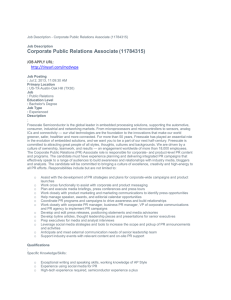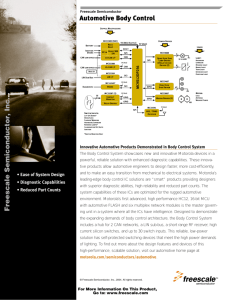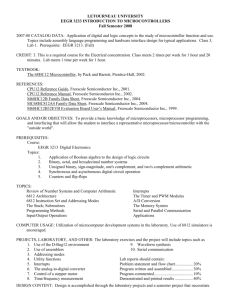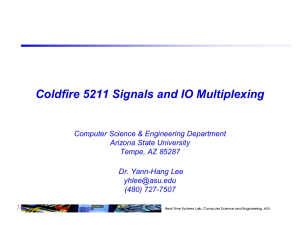Using General-Purpose Input Output on MCF521X ColdFire
advertisement
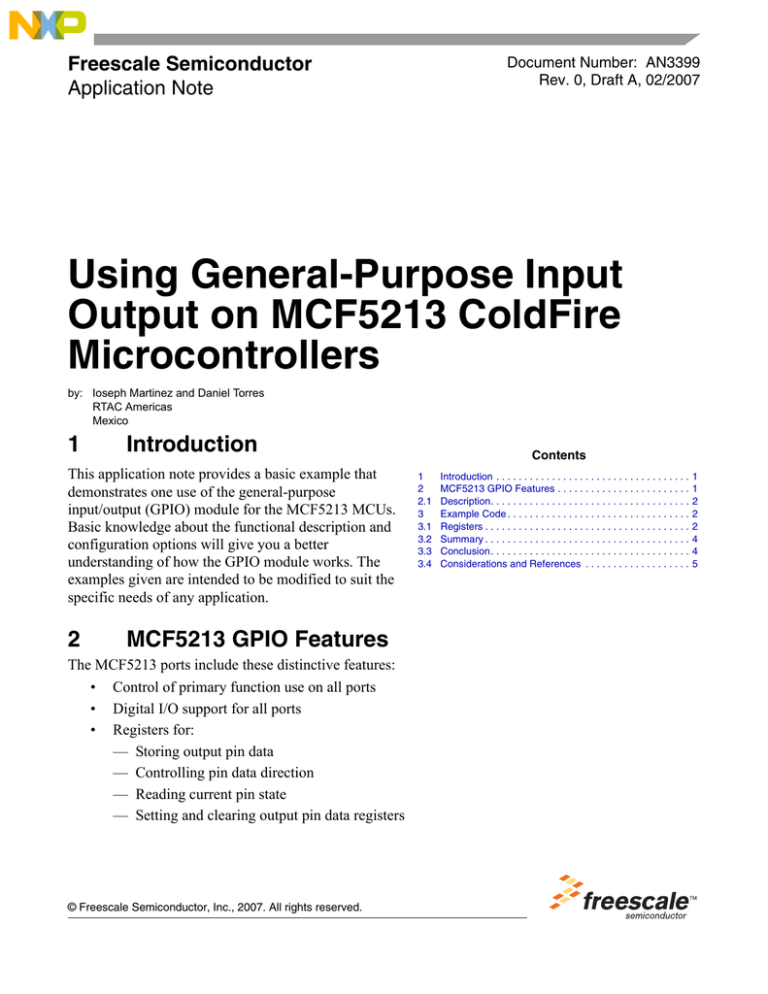
Freescale Semiconductor Application Note Document Number: AN3399 Rev. 0, Draft A, 02/2007 Using General-Purpose Input Output on MCF5213 ColdFire Microcontrollers by: Ioseph Martinez and Daniel Torres RTAC Americas Mexico 1 Introduction This application note provides a basic example that demonstrates one use of the general-purpose input/output (GPIO) module for the MCF5213 MCUs. Basic knowledge about the functional description and configuration options will give you a better understanding of how the GPIO module works. The examples given are intended to be modified to suit the specific needs of any application. 2 MCF5213 GPIO Features The MCF5213 ports include these distinctive features: • Control of primary function use on all ports • Digital I/O support for all ports • Registers for: — Storing output pin data — Controlling pin data direction — Reading current pin state — Setting and clearing output pin data registers © Freescale Semiconductor, Inc., 2007. All rights reserved. Contents 1 2 2.1 3 3.1 3.2 3.3 3.4 Introduction . . . . . . . . . . . . . . . . . . . . . . . . . . . . . . . . . . . MCF5213 GPIO Features . . . . . . . . . . . . . . . . . . . . . . . . Description. . . . . . . . . . . . . . . . . . . . . . . . . . . . . . . . . . . . Example Code . . . . . . . . . . . . . . . . . . . . . . . . . . . . . . . . . Registers . . . . . . . . . . . . . . . . . . . . . . . . . . . . . . . . . . . . . Summary . . . . . . . . . . . . . . . . . . . . . . . . . . . . . . . . . . . . . Conclusion. . . . . . . . . . . . . . . . . . . . . . . . . . . . . . . . . . . . Considerations and References . . . . . . . . . . . . . . . . . . . 1 1 2 2 2 4 4 5 Example Code 2.1 Description The MCF5213 MCU has 11 GPIO ports with respective configuration registers. The MCF5213 ports may also be used as GPIO. These ports are organized in groups of eight bits; some ports do not use all eight bits. The GPIO module configures the pins for reading, writing, clearing, setting, direction of data, and selection of slew rates and drive strength. 3 Example Code The example code was developed using the MCF5213 evaluation board (EVB). This code uses the four LEDs from the EVB that are located on port C. These pins are used as outputs. The SW1 and SW2 push buttons are also used to test the functionality of the inputs. The code configures the registers, allowing the use of the GPIO module. When this is done, the code starts to poll SW1 and SW2. If SW1 is pushed, it lights the four LEDs from the EVB. If SW2 is pushed, it performs a shift to the left of the value 0001b until it reaches the fourth LED and starts again. 3.1 Registers In the ports where not all of the eight bits are usable, writing to the non-usable bits has no effect. Refer to the MCF5213 ColdFire Integrated Microcontroller Reference Manual for more information. 3.1.1 Port Output Data Registers (PORTn) These registers store the data to be driven out when they are configured as outputs. The next lines of code show how to write to the PORTn register. /* Writing via Portn */ MCF_GPIO_PORTTC = (unsigned char)counter; 3.1.2 Port Data Direction Registers (DDRn) These registers control the direction of the data when the port is configured as GPIO. Setting DDRn will configure it as output; clearing it will do the opposite. The next lines of code show how to configure the data direction of the selected ports. /* DATA DIRECTION configuration */ /* PORTTC data direction as output PORTTC (3, 2, 1, 0) = 1; */ MCF_GPIO_DDRTC = 0 | MCF_GPIO_DDRTC_DDRTC3 | MCF_GPIO_DDRTC_DDRTC2 | MCF_GPIO_DDRTC_DDRTC1 | MCF_GPIO_DDRTC_DDRTC0; /* IRQ4 IRQ5 data direction configured as inputs */ /* this operation avoids changing the former values of the other pins in PORTNQ */ MCF_GPIO_DDRNQ = MCF_GPIO_DDRNQ & ~MCF_GPIO_DDRNQ_DDRNQ4 & ~MCF_GPIO_DDRNQ_DDRNQ5; Using General-Purpose Input Output on MCF5213 ColdFire Microcontrollers, Rev. 0, Draft A 2 Freescale Semiconductor Example Code 3.1.3 Port Pin Data/Set Data Registers (PORTnP/SETn) The PORTnP/SETn registers have two functions. When reading the current data in the port and setting bits in the port, clearing has no effect. They are used when some bits must be set. (Only one instruction is needed.) Below is the code for reading and setting PORTnP/SETn. /* Reading value from PORTnP */ unsigned char portValue; … portValue = MCF_GPIO_SETNQ; /* Setting port from SETn */ MCF_GPIO_SETTC = 0 | MCF_GPIO_SETTC_SETTC0 | MCF_GPIO_SETTC_SETTC1 | MCF_GPIO_SETTC_SETTC2 | MCF_GPIO_SETTC_SETTC3; 3.1.4 Port Clear Output Data Registers (CLRn) Writing 0s to a CLRn register clears the corresponding bits in the PORTn register. Writing 1s has no effect. Reading from the CLRn register returns 0s. It is used when some bits must be cleared. (Only one instruction is needed.) Below is the code for using the CLRn register. /* Clear all 4 leds of PORTTC via CLRn (if no SW is pushed) */ MCF_GPIO_CLRTC = (unsigned char)255 & ~MCF_GPIO_CLRTC_CLRTC0 & ~MCF_GPIO_CLRTC_CLRTC1 & ~MCF_GPIO_CLRTC_CLRTC2 & ~MCF_GPIO_CLRTC_CLRTC3; 3.1.5 Pin Assignment Registers There are three kinds of these registers: dual function, quad function, and one for the NQ assignment register. By writing 0s to dual function pin assignment registers will assign them to GPIO function. Writing 1s will assign them to their primary function. All bits are cleared to 0s at reset. The quad function pin assignment registers allow each pin controlled by each register bit to be configured among the GPIO function, primary function, alternate 1 function, and the alternate 2 function. In this case, each pin requires two bits for function assignment. Table 1 shows the double pin assignment for the quad function registers. Table 1. Double Bit Pin Assignment Register Bit Bit Value Pin Assignment 00 GPIO function 01 Primary function 10 Alternate 1 function 11 Alternate 2 function Using General-Purpose Input Output on MCF5213 ColdFire Microcontrollers, Rev. 0, Draft A Freescale Semiconductor 3 Example Code /* PORTC pins (leds in 5213EVB) Quad function*/ MCF_GPIO_PTCPAR = 0 | MCF_GPIO_PTCPAR_TIN3_GPIO | MCF_GPIO_PTCPAR_TIN2_GPIO | MCF_GPIO_PTCPAR_TIN1_GPIO | MCF_GPIO_PTCPAR_TIN0_GPIO; The port NQ pin assignment register contains both quad function (for IRQ1) and dual function pin assignment controls. Refer to the previous two sections for the encodings for the different fields. /* IRQ4 IRQ5 pins (SW1 SW2 on 5213EVB) */ MCF_GPIO_PNQPAR = 0 | MCF_GPIO_PNQPAR_IRQ4_GPIO | MCF_GPIO_PNQPAR_IRQ5_GPIO; 3.1.6 Pad Control Registers The pin slew rate register is read/write and each bit resets to 0. Setting the register makes the slew rate approximately 10 times slower. Clearing it configures the pin to a fast slew rate. Each bit resets to 0 in single chip mode and to 1 in EzPort/FAST mode. The pin drive strength register is read/write, and each bit resets to 0 in single chip mode (MCF5213 default) and 1 in EzPort and fast mode. For high drive strength (10 mA) set the register bits; for low drive strength (2 mA) clear the bits in the register. Each bit resets to 0 in single chip mode and to 1 in EzPort/fast mode. 3.2 Summary To use the GPIO module, you must: • Assign the GPIO functionality to the pins • Set the direction of the data (input or output) • Depending on the direction of the data, you may use one register or another to input or output data. 3.3 Conclusion Before using the GPIO module is important to know first which register to configure. The MCF5213 MCU’s ability to switch between a main function and GPIO allows the user to select any module and configure it as a GPIO when needed. 3.4 Considerations and References To find the newest software updates and configuration files for the MCF5213 MCU on the Freescale Semiconductor home page, visit www.freescale.com • MCF5213 Devices Supported: MCF5211, MCF5212, MCF5213. • M5213EVB Evaluation Board for Freescale MCF5213 MCU Hardware User Manual Doc. Rev. C • For more information on GPIO module refer to MCF5213 ColdFire Integrated Microcontroller Reference Manual. Rev 1.3 • The GPIODemo was developed with the CodeWarrior development tool for ColdFire® version 6.2 or higher. Using General-Purpose Input Output on MCF5213 ColdFire Microcontrollers, Rev. 0, Draft A 4 Freescale Semiconductor Example Code Using General-Purpose Input Output on MCF5213 ColdFire Microcontrollers, Rev. 0, Draft A Freescale Semiconductor 5 How to Reach Us: Home Page: www.freescale.com Web Support: http://www.freescale.com/support USA/Europe or Locations Not Listed: Freescale Semiconductor, Inc. Technical Information Center, EL516 2100 East Elliot Road Tempe, Arizona 85284 +1-800-521-6274 or +1-480-768-2130 www.freescale.com/support Europe, Middle East, and Africa: Freescale Halbleiter Deutschland GmbH Technical Information Center Schatzbogen 7 81829 Muenchen, Germany +44 1296 380 456 (English) +46 8 52200080 (English) +49 89 92103 559 (German) +33 1 69 35 48 48 (French) www.freescale.com/support Japan: Freescale Semiconductor Japan Ltd. Headquarters ARCO Tower 15F 1-8-1, Shimo-Meguro, Meguro-ku, Tokyo 153-0064 Japan 0120 191014 or +81 3 5437 9125 support.japan@freescale.com Asia/Pacific: Freescale Semiconductor Hong Kong Ltd. Technical Information Center 2 Dai King Street Tai Po Industrial Estate Tai Po, N.T., Hong Kong +800 2666 8080 support.asia@freescale.com For Literature Requests Only: Freescale Semiconductor Literature Distribution Center P.O. Box 5405 Denver, Colorado 80217 1-800-441-2447 or 303-675-2140 Fax: 303-675-2150 LDCForFreescaleSemiconductor@hibbertgroup.com Document Number: AN3399 Rev. 0, Draft A 02/2007 Information in this document is provided solely to enable system and software implementers to use Freescale Semiconductor products. There are no express or implied copyright licenses granted hereunder to design or fabricate any integrated circuits or integrated circuits based on the information in this document. Freescale Semiconductor reserves the right to make changes without further notice to any products herein. Freescale Semiconductor makes no warranty, representation or guarantee regarding the suitability of its products for any particular purpose, nor does Freescale Semiconductor assume any liability arising out of the application or use of any product or circuit, and specifically disclaims any and all liability, including without limitation consequential or incidental damages. “Typical” parameters that may be provided in Freescale Semiconductor data sheets and/or specifications can and do vary in different applications and actual performance may vary over time. All operating parameters, including “Typicals”, must be validated for each customer application by customer’s technical experts. Freescale Semiconductor does not convey any license under its patent rights nor the rights of others. Freescale Semiconductor products are not designed, intended, or authorized for use as components in systems intended for surgical implant into the body, or other applications intended to support or sustain life, or for any other application in which the failure of the Freescale Semiconductor product could create a situation where personal injury or death may occur. Should Buyer purchase or use Freescale Semiconductor products for any such unintended or unauthorized application, Buyer shall indemnify and hold Freescale Semiconductor and its officers, employees, subsidiaries, affiliates, and distributors harmless against all claims, costs, damages, and expenses, and reasonable attorney fees arising out of, directly or indirectly, any claim of personal injury or death associated with such unintended or unauthorized use, even if such claim alleges that Freescale Semiconductor was negligent regarding the design or manufacture of the part. RoHS-compliant and/or Pb-free versions of Freescale products have the functionality and electrical characteristics as their non-RoHS-compliant and/or non-Pb-free counterparts. For further information, see http://www.freescale.com or contact your Freescale sales representative. For information on Freescale’s Environmental Products program, go to http://www.freescale.com/epp. Freescale™ and the Freescale logo are trademarks of Freescale Semiconductor, Inc. All other product or service names are the property of their respective owners. © Freescale Semiconductor, Inc. 2007. All rights reserved.

